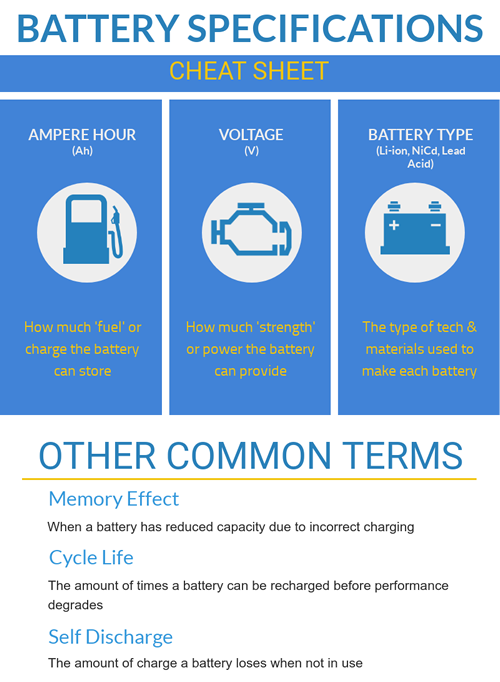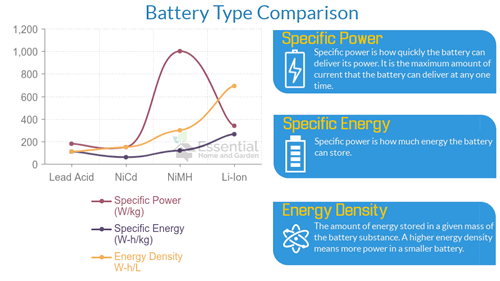Power Tool Batteries
- Makita Power Tool Batteries
- Bosch Cordless Drill Battery
- Dewalt Power Tool Batteries
- Panasonic Tool Battery
- Hitachi Tool Batteries
- Ryobi Power Tool Battery
- Milwaukee Drill Batteries
- Black & Decker Battery
- Paslode Power Tool Battery
- Dyson Vacuum Battery
- AEG Power Tool Battery
- Metabo Cordless Drill Battery
- Worx Power Tool Battery
- Dremel Power Tool Batteries
- Hilti Cordless Drill Battery
- Firestorm Tool Battery
- National Drill Batteries

Tool Battery > Australia Power Tool Battery Blog
The Complete Cordless Tools Battery Guide
Ampere hours, voltage, Li-Ion, NiCd. all these are terms that you might hear thrown around when you are looking at purchasing a new cordless tool. But what does it all mean? How do you know when the salesperson has no idea what they are talking about and just wants the commission?
Well, let's give you a bit of an education and go over the different battery types, ratings and everything else you need to know regarding batteries for cordless tools. That way you can be armed with all the info you need to make an informed decision.
How Battery Technology Has Improved
If you told a carpenter that you relied on nothing but a Makita drill battery to do all your screwing and drilling jobs 15 years ago they would have laughed at you, these days cordless drills, nailguns and other such cordless tools are their most used devices.
Battery technology has improved vastly over the past decade, and in some cases, the tools that they power can perform just as well as a corded tool.
One of the main problems with batteries in the past was their ability to last the distance. There is nothing more annoying than having your battery run out of juice halfway through a job.
Modern-day Li-Ion batteries can provide power for extended periods of time, and also recharge quite quickly - making them a worthwhile investment.
Which Battery Type is the Best for Cordless Tools?
The cordless tool industry has grown exponentially since the release of the Li-ion battery, mainly because of the vast improvement over the other older battery types.
Yes, it is true that some of the other battery types listed in this article are outdated, but they do still have their uses and they are still sold with some cordless tools such as cordless lawn mowers.
The super quick answer: If you want the quick answer as to which battery type is best, then you will probably want to go with a Li-ion battery.
Understanding Battery Capacity & Specifications
When you are shopping for a cordless tool, you will notice that you are bombarded with different battery specifications.
The most common specifications that are all over the packaging and marketing materials are:
- Voltage (V)
- And amp-hours (Ah)
- Battery type (Li-Ion, NiCd, NiMH)
Just choose the biggest numbers and you have the best battery?
While this seems like the obvious answer, it does depend on numerous factors... which we will look at.
Let's quickly explain some of the most commonly used terms when it comes to Bosch cordless tool batteries.

Cordless Tools Battery Types
Most guides that you read about cordless tools batteries will be focused mainly on Lithium Ion (Li-Ion) and that is with good reason. Li-Ion have become the go-to battery of choice for most cordless tool manufacturers. This for a few reasons:
- They provide a lot of power from a small battery (high energy density)
- They can be recharged many times (high cycle life)
- High capacity (Ah/Specific energy)
- No memory effect
Before we go into too much detail, let's take a quick visual look at the difference between the 4 main battery types.
We often get asked which batteries are better or which type is better.
Well we have tried to make it simple to compare the different battery types with this handy image below.

Maybe - but it does give us a few important insights into the battery types. From this info, we can take the following away:
- For high current applications (digital cameras, high power torches etc) NiMH is clearly the best choice. This is because NiMH batteries are capable of delivering a high burst of power when needed (The specific power number is huge).
- But.The amount of power they can actually store is lower than a Li-Ion battery.
- Lead Acid and NiCd batteries are pretty much obsolete these days.
So the long and the short of it is: A Li-Ion battery is smaller and can provide a lower current for a much longer period than a NiMH Dewalt battery. But a NiMH battery can deliver high bursts of current when needed.
Charging Cordless Tool Batteries
In the past, you could mix and match different chargers with different rechargeable batteries. These days most cordless tool batteries are designed to work with a specific charger, especially those with Li-Ion batteries. You will find that Lead Acid batteries can be charged in many different ways, but it is always best to follow the manufacturers instructions and use the charger that the manufacturer provided with the tool.
The Future Of Cordless Tool Batteries
If I could turn on my crystal ball and tell you exactly where battery technology was heading..I would! Unfortunately, my crystal ball is in being repaired!
But, I can tell you what I do know and what some of the worlds most renowned battery experts know.
The truth is that at the moment, there is no magical battery technology being developed that will change the world. While there are some theories of technologies that MIGHT work - there really are no working models for the moment.
There is, however, lots of money being spent on improving Li-Ion battery tech. This is due to the rise of electric cars and stationary battery energy storage (for storing energy generated from wind and solar power). So we should see a new generation of Li-Ion batteries being developed that will slowly take over the market as manufacturing ramps up and costs come down.



Product names, logos, brands and other trademarks are the property of their respective trademark holders in Australia and other countries.
Copyright © 2010-2025 At www.drill-battery-au.com. All Rights Reserved.
